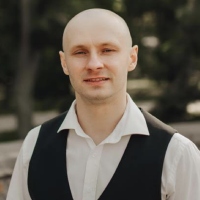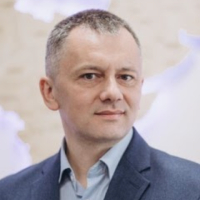Speakers

Machine learning fundamentals
«How to survive the Titanic?» This shot workshop is intended to provide You with knowledge of basics in Statistic, Machine Learning, Data Mining with the usage of state-of-the-art models such that Decision Tree and Random Forest for classification task. Target audience: 1+ month experience in Python; Intermediate English. Learning outcomes: Basic understanding of Machine Learning; Hands-on experience with the state-of-the-art models Decision Tree and Random Forest.

Transformers, BERT, GPT models family (GPT-1, 2, 3, 3.5, 4), LlaMA, DeepSeek
We will explore the evolution of transformer-based machine learning models through the lens of BERT, GPT family, LlaMA, and Mixtral. The discussion will cover the development, functionality, and advancements these models brought to various sectors like natural language processing and information retrieval. We will start from transformers and move deeper into more advanced architectures. We consider practical use cases to use them in business applications and in life.

MS Azure
This lecture provides an overview of Microsoft Azure’s essential cloud services, focusing on its core offerings: Compute services, Database solutions and Storage options The lecture also highlights Azure’s monitoring and diagnostics tools like Azure Monitor and Application Insights. By the end of the session, attendees will gain a clear understanding of how to leverage Azure to build and manage cloud-based applications effectively.

Database basics, relational, non-relational, distributed databases
We'll run through the overview of the DB basics, ways to operate with, and main use cases. In a nutshell we will cover how relational databases organize structured data, how NoSQL databases handle unstructured data, and the benefits of distributed databases for scalability and fault tolerance.

Version Control System basics: Git, Data Version Control (DVC), Data sources (Kaggle, etc.), ML Hubs (Hugging Face, etc.)
At this lecture will understands fundamental of Version Control System, will discuss example of VCS platform. Additionally, we'll examine various data sources like Kaggle, which provide vast datasets for analysis and model training, and discuss how to integrate these into your projects.

Data warehouse, ETL, Data Workflows
This lecture will explore the use of data warehouses in business analytics using visualization tools — Power BI and Tableau. It is shown how to connect reports to data warehouses, build interactive dashboards and create relationships between tables. We will also consider the ETL process, which is important for preparing data for analysis. It describes in detail three key stages: extracting data from source systems, converting it to an appropriate format and loading it into a data warehouse. The lecture includes real-world examples, tools and development of data processing workflows. This lecture also focuses on the design and automation of data processing tasks. Topics include workflow planning, dependency management and monitoring using various modern tools.

NLP libraries and frameworks, NLTK
This lecture provides a clear overview of Natural Language Processing (NLP), tracing its history and essential text processing pipeline. We’ll explore popular NLP frameworks, with a special focus on the NLTK library. A practical demo will illustrate how NLTK is applied to real-world language tasks

Neural networks & Deep learning architectures
This lecture will explore the fundamental principles of neural networks, beginning with the basic building block of a neuron and its role in processing information. We'll examine the core mechanisms of feedforward propagation and how networks learn through backpropagation, including an overview of optimization methods like gradient descent. The session will then expand to robust architectures such as Convolutional Neural Networks for spatial data and Recurrent Neural Networks for sequential information, with a glimpse into the advancements of Transformers. We'll also touch upon the ecosystem of popular deep learning frameworks.

AWS in Action
The lecture provides an overview of essential AWS services—S3, EC2, and Lambda—used to deploy and scale modern cloud applications. It combines a concise theoretical introduction with a practical session where participants build and run a basic cloud-native application using these services.

Cloud computing basics, SaaS, PaaS and IaaS
This lecture breaks down cloud computing into its three service layers: IaaS (rent configurable servers, storage, and networks), PaaS (build and deploy code on a managed runtime), and SaaS (consume fully hosted applications). We’ll review the essential cloud traits - on-demand access, elasticity, and pay-as-you-go pricing. By the end, you’ll know when to pick each model, the trade-offs in control vs. convenience, and the cost and security factors that matter most.

Generative AI fundamentals

Python for visualisation
We will explore Python as a data visualization tool, demonstrating how to transform raw data into clear and insightful visual stories. We will walkthrough some of the core libraries, such as Matplotlib, Seaborn, and Plotly, and how to use them to build various charts.

Introduction to Quantum Mechanics and Quantum Computing
A quantum computer is a device that performs computation using the principles of quantum mechanics. The essence of quantum programming lies in exploiting uniquely quantum phenomena, such as superposition and entanglement, to achieve quantum advantage. Therefore, a solid understanding of quantum mechanics is essential for anyone aspiring to become a quantum programmer.
The goal of these lectures is to introduce the audience to both quantum mechanics and quantum computing in a minimal amount of time, without compromising coherence or rigor. Unlike the traditional sequential approach, where quantum mechanics is taught first and quantum information and computing are introduced later, this course presents both subjects simultaneously and in parallel

AI Hallucinations: When Artificial Intelligence Gets It Wrong — and Why It Matters
This session will explore why large language models like ChatGPT sometimes generate incorrect or fabricated content, how to recognize these hallucinations, and what techniques can be used to mitigate their impact in real-world applications. The lecture will include interactive elements such as live model demos and audience participation via polling.

AI Project Leadership: Managing Risk, Change, and Value in Algorithmic Systems
As machine learning projects move from lab to mission-critical infrastructure, traditional project management tools fall short. This lecture explores how executive leadership must rethink delivery, risk, and quality in AI-intensive environments. Key theses include:
- ML/AI initiatives require hybrid project models that combine Agile iteration with robust validation milestones.
- New risk categories—like model drift, regulatory exposure, and ethical liability—must be proactively managed.
- Cross-functional stakeholder communication becomes central to controlling scope, maintaining trust, and ensuring accountability.
- Executives must shift from output-focused KPIs to adaptive, value-driven goals.
Human-Centered Leadership in AI Transformation: Emotional Intelligence, Trust, and Cultural Change
AI is as much a cultural disruption as it is a technological one. This lecture explores how emotional intelligence, transparent communication, and team resilience are make-or-break factors in enterprise AI success. Key theses include:
- Emotional intelligence helps leaders anticipate resistance, reduce stress, and increase adaptability during high-change projects.
- Open, clear communication is crucial in managing expectations between business, technical, and compliance teams.
- Leadership must actively build a psychologically safe environment that encourages innovation, learning, and accountability.
- Behavioral soft-skills—often neglected—are central to sustaining long-term transformation in AI-augmented organizations.

AI in Application Security: From Offensive Tactics to Defensive Practices
In this presentation, we’ll explore how artificial intelligence is reshaping the world of application security — from red team tactics to blue team defenses. Victoria will demonstrate how AI can enhance penetration testing, support the evaluation of AI-powered applications through adversarial testing techniques. On the defensive side, she'll dive into how AI accelerates secure code reviews, improves threat modeling, and augments security throughout the software development lifecycle. This talk will provide a practical tips & tricks on integrating AI into AppSec strategies.

Securing the Cloud with AI: Audits, Reviews, and Threat Modeling

Building AI Systems with Azure AI Foundry
This practical session offers a dynamic blend of theory and hands-on experience focused on designing and deploying AI systems with agents using Azure AI Foundry. Participants will gain insights into the core components of the Foundry ecosystem, including model orchestration, retrieval-augmented generation (RAG), multi-agent workflows, and responsible AI tools. Through live demonstrations, attendees will learn how to build and operationalize AI agents within a secure, scalable Azure environment.

Quantum algorithms and quantum supremacy
In the lecture the basic quantum algorithms will be considered in detail. The implementation of these algorithms on quantum simulators, as well as on real quantum computers, will be explained. Achieving quantum supremacy will be discussed. Original quantum protocols and results of quantum computing will also be introduced. Finally, open problems in the field of quantum information will be addressed.

Quantum Teleportation
In 1993, a scheme for the quantum teleportation of a qubit state was proposed. In 1997, this scheme was experimentally realized for the first time using photon states by Anton Zeilinger's research group. For his contributions to quantum information, Zeilinger was awarded the Nobel Prize in Physics in 2022. This scheme, which employs an ancilla qubit, enables the unknown state of one qubit to be teleported to another. Its implementation requires the preparation of a quantum channel in the form of an entangled state, along with a classical communication channel to complete the teleportation process – ensuring that the transfer does not exceed the speed of light. This scheme will be analyzed in detail in the lecture.

Quantum Programming
This lecture provides an overview of the fundamental concepts of quantum computing — a computational paradigm based on the principles of quantum mechanics. Starting from the basics of quantum programming, we will demonstrate the potential of this new technology through the implementation of key quantum algorithms.

Real-time 3D face reconstruction
In this talk, you’ll see how a single photo or video can become a fully rotatable 3D face in just a few steps. We start by finding the face in the picture, then build a 3D model that matches the features, and finally bring it to life on screen using a fast core program with simple helper scripts. You’ll watch a live demo where an example selfie is transformed in seconds, and discover how the same technique drives character creation in video games and movies, powers virtual-reality experiences, and even helps doctors plan facial surgeries. Practical, hands-on, and ready to inspire your next project.

Boosting Investment Strategy Performance with Market Regime Detection
Using simple ML models to identify market conditions and dynamically adjust exposure levels of the chosen investment strategy to improve returns and manage risk.

Cybersecurity and AI: Collaboration, Risks, and Future Trends (in Ukrainian)
Artificial intelligence is not only a revolutionary tool but also a new challenge for cybersecurity. In this lecture, we will explore how AI is transforming the protection of digital systems — from automating threat detection to real attacks generated by LLMs themselves. You will learn how AI and Security are interconnected, what new risks are emerging, and which international standards already regulate the secure use of AI.
Special attention will be given to practical examples, current trends, and future professions at the intersection of AI and cybersecurity.
This lecture will be valuable for anyone who wants to understand not only how artificial intelligence works, but also how to implement and use it securely.

Prompt Engineering for AI: Prompting with Purpose: How Language Shapes the Ethics and Effectiveness of AI
What is prompt engineering? And why it matters more than you think. How prompts shape AI behavior - not just results, but tone, bias, and intent. Why language isn’t neutral - every word carries assumptions. Ethical risks - how poorly designed prompts can reinforce harmful patterns. Best practices - how to write prompts that are effective and responsible

Machine learning projects/models to solve practical problems
This lecture will cover the main aspects and problems of machine learning and how to solve practical problems. I will describe what approaches are the best for classical ML and Deep Learning. Through a short demo, I will show that we should not solve some problems from the scratch;
Deep learning for forecasting
Now-a-days many problems could be solved using just deep learning, but some problems you can not solve using out-of-the-box models. Custom multimodal problems could help us in this case. At the lecture we will consider:
- Simple regression example
- Autoencoders (neural networks)
- Multimodal architectures.

Living Intelligence: Dynamic Neural Network Adaptation Without Retraining.
We will present Sakana AI’s revolutionary Transformer² technology, the first out-of-the-box system with dynamic adaptation of neural network weights in real time. Unlike traditional approaches that require retraining or fine-tuning for each new task, Transformer² uses a singular decomposition-based method to instantly transform a model to specific domains. The talk includes a technical explanation of the architecture, a demonstration of model adaptation across domains from different scientific fields, and practical recommendations for applying this technology in research.

Computer Vision on Drones: Challenges and Solutions
In this presentation, we’ll explore how drones use computer vision and machine learning to detect objects, follow them, and estimate how far away they are. You’ll learn how object detection and tracking work, what challenges arise when using cameras in the sky, and how we can teach drones to “measure” distances using just images. We’ll also look at some principles of visual navigation. No prior experience is needed — just curiosity and interest in how drones can think with the help of A

Linear and Nonlinear Methods of Reducing Dimensionality
This lecture offers a conceptual introduction to the main approaches used in dimensionality reduction, a key process in data analysis and machine learning.
We will examine both linear methods, such as Principal Component Analysis (PCA) and Singular Value Decomposition (SVD), and nonlinear techniques like t-SNE, focusing on their mathematical foundations and the types of data they are best suited for.
The lecture aims to clarify why and when dimensionality reduction is needed, how it affects the structure of data, and what assumptions different methods rely on. No implementation or application is required — the focus remains on intuitive understanding and comparative analysis of the methods.
NLP and Speech recognition
This lecture provides a theoretical introduction to the fields of Natural Language Processing (NLP) and Speech Recognition, focusing on fundamental concepts, terminology, and general workflows.
We will explore how language is represented in computers, how basic NLP operations like tokenization and lemmatization are performed, and how speech signals are transformed into textual data.
The goal of the lecture is to build an initial understanding of how machines can process language and speech, forming a basis for more advanced study in computational linguistics, machine learning, or artificial intelligence.

Advanced Fall Detection for Elderly Care: Leveraging Machine Learning and AI
This presentation explores cutting-edge machine learning algorithms and artificial intelligence techniques for real-time fall detection systems designed specifically for elderly care environments. The research covers computer vision-based approaches, wearable sensor integration, and hybrid detection models that achieve high accuracy while minimizing false positives. Key topics include deep learning architectures for pose estimation, edge computing implementation for privacy-preserving solutions, and clinical validation results from assisted living facilities.

AI vs. Disinformation: Using Machine Learning and LLMs to Detect and Track InfoOps
How can machine learning and large language models (LLMs) be used to detect disinformation campaigns in real time? In this session, Andriy Kusyy—CEO of LetsData—will walk through the core ML and LLM-based techniques used to uncover coordinated influence operations across media and social networks. The first half of the session will include a 20–30 minute deep dive into the practical technologies behind real-world InfoOps detection, followed by a live Q&A focused on use cases, challenges, and applications in government, cybersecurity, and enterprise settings. One real use case will be presented to illustrate the end-to-end detection pipeline.

ChatGPT usage, ChatGPT API, tokenisation, creation and usage of GPTs

Workshop: Building a GenAI Agent for Personalized Nutrition Tracking
In this workshop, you'll learn how to build a GenAI-powered agent that helps track nutrition—calories, carbs, and more—based on user input. We'll walk through the key components, show how to build the agent in Python, and demonstrate it in action

Speaker at the opening ceremony
Fingerprint Presentation Attacks - How can we tell a real fingerprint from a fake one?
This lecture dives into the fascinating world of fingerprint Presentation Attack Detection (PAD), exploring how cutting-edge research is staying ahead of increasingly sophisticated spoofing techniques. Drawing from the recent work of the sAIfer Lab's Biometric Unit, we will examine how realistic fake fingerprints—known as presentation attack instruments—are created and how their threat levels are assessed. The session will spotlight the ninth edition of the International Fingerprint Liveness Detection Competition (LivDet 2025), offering a behind-the-scenes look at its challenges, goals, and some preliminary insights ahead of their official unveiling at IJCB 2025. Looking ahead, we’ll discuss open problems and emerging trends in fingerprint PAD, setting the stage for future research. As part of the lecture, participants will engage in hands-on lab exercises to better understand the practical aspects of liveness detection and biometric security.

1. Speaker at the opening ceremony
2. Exploring the Prospects for Establishing an International Master’s Program on Artificial Intelligence in Cybersecurity, Led by Lviv University in Partnership with Universities from Finland, the Netherlands, and Italy
Prospects for creating an international master's program in cybersecurity and AI with the leadership of Lviv University and universities in Finland, the Netherlands, and Italy. Steps that have been implemented. Tasks that need to be completed.

Databases: Innovative Approaches to Data Storage and Processing
This session will provide an overview of modern database types and storage strategies, with a focus on innovations and cloud solutions. We’ll explore how to choose the right database for various business needs and examine how Microsoft Azure simplifies data handling.

GenAI — The Future of Automated Transformation in Data & Analytics
This presentation explores the role of artificial intelligence in transforming data migration approaches within modern analytical platforms. Special attention is given to how AI technologies facilitate code conversion automation, reduce costs, accelerate implementation, and improve migration quality.
Attendees will gain insight into modern tools, architectural approaches, and practical aspects of implementing AI solutions in the context of data transfer across technological environments.

AI Coworkers and how they change the workplace
AI coworkers are no longer a futuristic idea—they are already changing how we work today. From automating routine tasks to supporting decision-making and enhancing team productivity, AI is being embedded into everyday workflows across industries. This session explores real-world examples of how companies are integrating AI into their operations, what roles these systems are playing, and how they’re reshaping collaboration between humans and machines.

AI Code generation. Cursor Agent: Practical Use Cases and Tips
This speech offered practical insights into using an AI agent for software development, drawing on real-world experiences. The presentation shared valuable tips for effective AI code generation, emphasizing the significance of providing clear context, breaking down tasks, and utilizing other common developer tools into the coding process.

AI as a game changer in Software Development

Intellectual Monitoring for Multi-Agent Systems
This talk explores intellectual monitoring for multi-agent systems, focusing on adaptive, knowledge-driven oversight in dynamic, distributed environments. We introduce a hybrid architecture that combines local agent awareness with global reasoning, enabling real-time diagnostics, coordination, and fault tolerance. Leveraging ontologies, digital twins, and explainable AI, the approach ensures agents can self-monitor, learn from interactions, and collaborate effectively.

Speaker at the opening ceremony

Speaker at the opening ceremony

Speaker at the opening ceremony

Speaker at the opening ceremony

Applying elements of AI technologies in Software Test Automation Engineering
The presentation is dedicated to the use of large language models (LLMs) in the field of software test automation. It will demonstrate how LLMs accelerate the automation process through test generation, web element identification, and test result analysis, as well as discuss their advantages and limitations.

Soon...

Transformer Models: architecture, capabilities, and applications
On the lecture you will explore the world of language models and discover how the transformers architecture revolutionized deep learning and enabled generative artificial intelligence development. We will review the transformer architecture from the group up, component by component. Such topics will be covered as part of the lecture:
1) The role of positional encoding
2) Attention mechanism
3) Multi-head attention
Also, you will learn how to choose the most appropriate transformer model architecture on HuggingFace for your tasks. Python knowledge and understanding of ML/NLP concepts is mandatory.

Collaboration and teamwork: how to work in a multi-ethnic and multi-cultural teams?
1. Cultural Awareness
Understand and respect different cultural norms, communication styles, and values.
2. Inclusive Communication
Use clear, simple language and practice active listening to avoid misunderstandings.
3. Building Trust
Create a safe environment where everyone feels comfortable sharing ideas.
4. Shared Goals
Define common objectives and team norms that respect cultural preferences.
5. Power of Diversity
Use diverse perspectives to boost creativity, innovation, and problem-solving.
6. Conflict Management
Address misunderstandings constructively and with cultural sensitivity.
7. Continuous Learning
Encourage development of intercultural competence through training and experience sharing.

Teamwork: People, Problems, and Tools
This lecture explores teamwork by looking at key team roles, common problems, and ways to solve them. It emphasizes the importance of communication, understanding tasks, and developing emotional intelligence. Methods and tools that help build an effective and collaborative team are also introduced.

RAG Architecture
Let's talk about the basic concepts, practical applications, and challenges in building RAG applications.

Ethical Persuasion for Future Tech Innovators: The Ultimate Business Skill
As part of the prestigious AIT-2025 International Summer School hosted by Ivan Franko National University of Lviv, this live-streamed session led by Ezio Sabatino—Certified Cialdini Coach and Official Partner and Chief Influence Officer—equips top computer science students with a mission-critical advantage: ethical persuasion.
In an increasingly AI-driven world, technical expertise alone isn’t enough. Whether pitching a project, leading a team, or collaborating across borders, the ability to influence ethically is what sets the most impactful professionals apart.
Students will learn how to apply the Cialdini 7 Universal Principles of Persuasion—backed by behavioral science and used by the world’s most successful leaders—to communicate more effectively, build trust, and inspire action with integrity.
This fast-paced, interactive session is designed for high-potential students who want to amplify their soft skills and stand out in the global tech arena.

- GenAI Trends + Ask the Architect
We’ll explore the latest trends in GenAI, real-world use cases with our customers, and how AWS is helping companies build smarter with scalable AI solutions.In the second part of the talk, you’ll get the unique opportunity to “Ask the Architect” — bring your questions about cloud, architecture, career growth, or anything else you’ve always wanted to ask someone working inside AWS. Whether you're a future developer, ML engineer, or entrepreneur, this session is designed to inspire and inform.
- RAG, Agentic AI, MCP on AWS
Join us for a deep dive into the latest GenAI trends, including Retrieval-Augmented Generation (RAG), Agentic AI, and model customization techniques. You'll learn how these concepts are being implemented using AWS services like Amazon Bedrock and vector databases.
- Workshop on building Agentic Systems using Amazon Bedrock and Open-source Frameworks
Learn how to build Agentic AI systems using Amazon Bedrock and open-source tools. This hands-on workshop will guide you through creating goal-driven AI agents that can reason, act, and retrieve information using foundation models on AWS. You'll gain practical experience designing intelligent workflows powered by cloud-native GenAI components.

- GenAI Trends + Ask the Architect
We’ll explore the latest trends in GenAI, real-world use cases with our customers, and how AWS is helping companies build smarter with scalable AI solutions.In the second part of the talk, you’ll get the unique opportunity to “Ask the Architect” — bring your questions about cloud, architecture, career growth, or anything else you’ve always wanted to ask someone working inside AWS. Whether you're a future developer, ML engineer, or entrepreneur, this session is designed to inspire and inform.
- RAG, Agentic AI, MCP on AWS
Join us for a deep dive into the latest GenAI trends, including Retrieval-Augmented Generation (RAG), Agentic AI, and model customization techniques. You'll learn how these concepts are being implemented using AWS services like Amazon Bedrock and vector databases.
- Workshop on building Agentic Systems using Amazon Bedrock and Open-source Frameworks
Learn how to build Agentic AI systems using Amazon Bedrock and open-source tools. This hands-on workshop will guide you through creating goal-driven AI agents that can reason, act, and retrieve information using foundation models on AWS. You'll gain practical experience designing intelligent workflows powered by cloud-native GenAI components.


